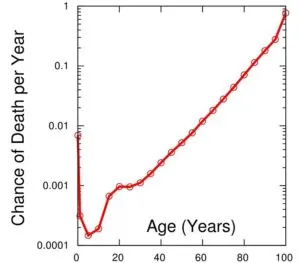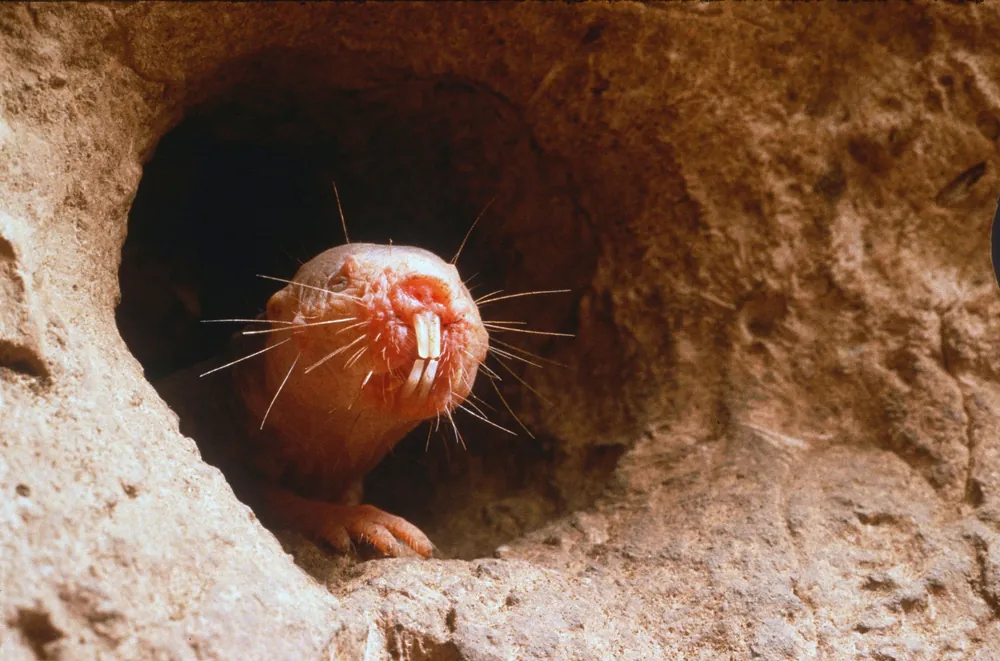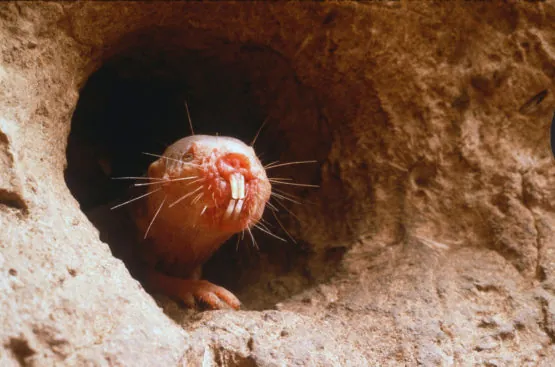Completely bald and with wrinkly skin, the naked mole rat is one of the ugliest creatures around but lives an exceptionally long life for a small mammal. It rarely develops the chronic diseases of aging, such as cancer, and lives 10 times longer than regular rats.
The First Non-Aging Mammal
In the first significant announcement from Calico Labs since it was formed in 2013, researchers Rochelle Buffenstein, Megan Smith, and J. Graham Ruby have announced that the naked mole rat is a “non-aging mammal.”
The researchers followed the naked mole rats – housed at the Buck Institute – over a three-decade-long study period. They found that these creatures show hardly any signs of aging, such as problems with their metabolism, heart, or bones. Females do not go through menopause and continue to reproduce into their 30s, which is an amazing feat for an animal that lives at least 30 years of age in captivity. Even the cells in their bodies have a remarkable resistance to oxidative damage caused by free radicals. Small rodents the size of the naked mole rat live for no more than six years.
Senior Principal Investigator Rochelle (Shelley) Buffenstein, Ph.D. spent the early part of her career at the Medical School of the University of Witwatersrand, South Africa, where she studied the naked mole rat for ten years. Principal Investigator J. Graham Ruby, Ph.D. received his doctorate in biology from MIT and performs biometric, biostatistical, bioinformatic, and quantitative genetic analyses of diverse data to decipher the aging process in humans and model organisms. The researchers published their results on Jan 24th in the open access journal eLife[1].
How the Non-aging Mammal Was Discovered
To judge the rate of aging, the Calico team used a mathematical model called the Gompertz-Makeham law of mortality. This statistically validated law states that the risk of death for every mammal increases exponentially with increasing age. The Calico researchers used this model to analyze an existing data set of more than 3000 naked mole rats over a 30-year timespan and found that the small mammals did not conform to the Gompertz-Makeham law. Unlike every other mammal, the mole rats do not face an increased hazard of death with each birthday; as the Calico authors said, “This absence of hazard increase with age, in defiance of Gompertz’s law, uniquely identifies the naked mole-rat as a non-aging mammal.”

Estimated probability of a US person dying at each age (2003.) Credit: Uscitizenjason CC BY SA 3.0
This is astonishing given that all other mammals, including humans, face an increased rate of death with each passing birthday. Consider this hazard chart for US citizens in 2003, in which the mortality rates increase exponentially with age after the age of 30. In contrast, the equivalent chart for the naked mole rat is almost flat.
Caleb E. Finch and Hiram Beltrán-Sánchez, a pair of scientists from the University of Southern California (USC) in Los Angeles, analyzed and commented on the study. Caleb E. Finch, Ph.D. is a molecular biologist in the Leonard Davis School of Gerontology and Dornsife College. Hiram Beltrán-Sánchez is from the Department of Community Health Sciences and the California Center for Population Research.
Commenting on the remarkable results of the study in a companion piece[2], Finch and Beltrán-Sánchez said that the naked mole rat defied the Gompertz-Makeham law, remarking, “their risk of death does not increase as they get older” and “this is unprecedented for mammals.”
Finch and Beltrán-Sánchez said that previous studies of the non-aging mammal suggest that aging creeps in, nevertheless. Naked mole rats can accumulate oxidative damage in their cells and experience muscle wasting. There is also some evidence for small amounts of cancer. But, after reviewing the evidence, the USC authors said, “This would suggest that unlike any other mammal, the naked mole rats have an extremely low rate of aging.”
Finch and Beltrán-Sánchez said that the minimal age-related problems of the mole rat combined with its long lifespan allow it to achieve ‘negligible senescence,’ a phenomenon in which an animal reaches an advanced age without increased mortality or disability.
Other scientists believe that the longevity of naked mole rats is due to the limited oxygen of their subterranean habitat. Because of this environment, their metabolic rates are abnormally slow, and an abundance of repair mechanisms keeps their cells astonishingly youthful.
About Longevityfacts
We have teamed up with our friends at Longevityfacts and will be publishing some of their articles as part of an agreed syndication deal. This article originally appeared here at Longevityfacts.
Literature
[1] J Graham Ruby, Megan Smith, Rochelle Buffenstein, Calico Life Sciences LLC. “Naked mole-rat mortality rates defy Gompertzian laws by not increasing with age.” eLife 2018;7:e31157 DOI: 10.7554/eLife.31157, Jan 24, 2018.
[2] Hiram Beltrán-Sánchez, Caleb Finch. “Life Expectancy: Age is just a number.” eLife 2018;7:e34427 DOI: 10.7554/eLife.34427 Jan 24, 2018.





